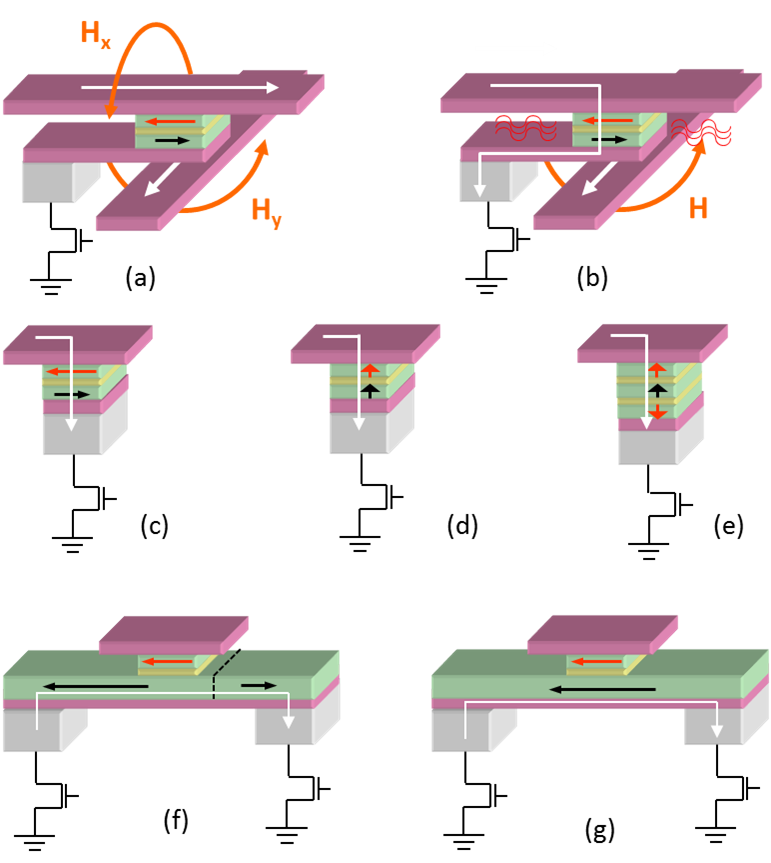Thematic overview
Magnetic Random Access Memories (MRAM) is a non-volatile memory technology, where information is stored by the magnetization direction of magnetic electrodes, very similar to computer hard-disk drives. The goal for MRAM memory is to simultaneously achieve high-speed read/write times, high density and unlimited cycling compared to other existing and emerging technologies.
Our group is developing advanced MRAM cell concepts patented at Spintec. The concepts are based on the use of temperature to reduce power consumption and increase the stability of the stored information. These ideas go beyond the conventional MRAM approach. The naturally occurring temperature increase during the write step is not lost, but is instead used to achieve the seemingly opposing goal of lowering the power consumption and increasing the thermal stability in the operating temperature range. Our group fosters young and experienced researchers developing/applying their expertise in the field of MRAM.

Questions to be addressed
Our main research axis is to use the naturally occurring temperature increase during the write step, when a current flows through the magnetic tunnel junction. The heating is used to go above a temperature threshold, making it possible to write the storage layer magnetization. This principle has been applied to in-plane magnetization cells using a storage layer pinned by an anti-ferromagnet and recently to perpendicular anisotropy cells. Our group’s goal is to demonstrate the proof-of-concept and then improve MRAM cell properties.
Our work involves the development of magnetic material systems, nano-fabrication (20-200nm cells), characterization of devices (magnetic & electrical) and simulation of the device behavior. Our activity in these vast fields is as follows;: On materials research, we are developing magnetic tunnel junctions with in-plane and perpendicular magnetic anisotropy. New electrode stacks having the material properties required by each specific concept need to be integrated in magnetic tunnel junctions, while achieving high levels of TMR signal. For the characterization of each concept we determine the write window parameters in terms of magnetic field, power consumption and magnetization reversal dynamics. Macrospin and micromagnetic simulation provide a better physical understanding of the system properties and the possibilities for optimization.
Projects
ANR EXCALYB – Perpendicular Anisotropy Materials for High-Density Non-volatile Magnetic Memory Cells
Crocus R&D – Thermally assisted MRAM
Samsung SGMI
Partners
Crocus Technology
Institut Néel
SP2M/NM
SAMSUNG
Applied Materials
SINGULUS
Recent news
- EMERGING NON-VOLATILE MEMORIES: MAGNETIC AND RESISTIVE TECHNOLOGIES [July 02nd, 2015]
B Dieny In 2010, the International Technology Roadmap for Semiconductors (ITRS) published an assessment of the potential and maturity of selected emerging research on memory technologies. Eight different technologies of non-volatile memories were compared (ferroelectric gate ... - ELECTRICAL MODELING OF STOCHASTIC SPIN TRANSFER TORQUEWRITING INMAGNETIC TUNNEL JUNCTIONS FOR MEMORY AND LOGIC APPLICATIONS [July 02nd, 2015]
Yue Zhang , Weisheng Zhao , Guillaume Prenat , Thibaut Devolder , Jacques-Olivier Klein , Claude Chappert , Bernard Dieny , and Dafiné Ravelosona Magnetic tunnel junctions (MTJ) are considered as one of the most promising ... - COMPARISON OF DISPERSION AND ACTUATION PROPERTIES OF VORTEX AND SYNTHETIC ANTIFERROMAGNETIC PARTICLES FOR BIOTECHNOLOGICAL APPLICATIONS [July 02nd, 2015]
S. Leulmi, H. Joisten, T. Dietsch, C. Iss, M. Morcrette, S. Auffret, P. Sabon, and B. Dieny Magnetic nanoparticles are receiving an increasing interest for various biotechnological applications due to the capability that they offer to ... - DIFFUSIVE MODEL OF CURRENT-IN-PLANE-TUNNELING IN DOUBLE MAGNETIC TUNNEL JUNCTIONS [July 02nd, 2015]
We propose a model that describes current-in-plane tunneling transport in double barrier magnetic tunnel junctions in diffusive regime. Our study shows that specific features appear in double junctions that are described by introducing two typical ... - MAGNETIC RANDOM ACCESS RANDOM ACCESS [July 02nd, 2015]
1 Introduction 2 Magnetic Tunnel Junctions: A Route for CMOS/Magnetism Integration 3 Spin-Transfer Phenomenon 4 Magnetic Random Access Memories (MRAM) 4.1 Stoner-Wolfarth MRAM (SW-MRAM) 4.2 Toggle MRAM 4.3 Spin-Transfer Torque MRAM (STT-MRAM) 4.4 Thermally Assisted MRAM (TA-MRAM) 5 Racetrack Memories

SOUSA Ricardo
ricardo.sousa@cea.fr

BALTZ Vincent
vincent.baltz@cea.fr

PREJBEANU Lucian
lucian.prejbeanu@cea.fr

DIENY Bernard
bernard.dieny@cea.fr





